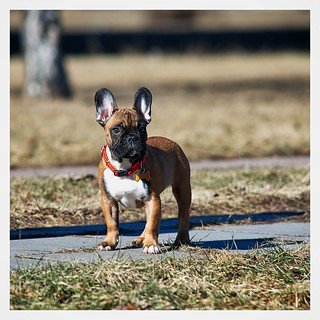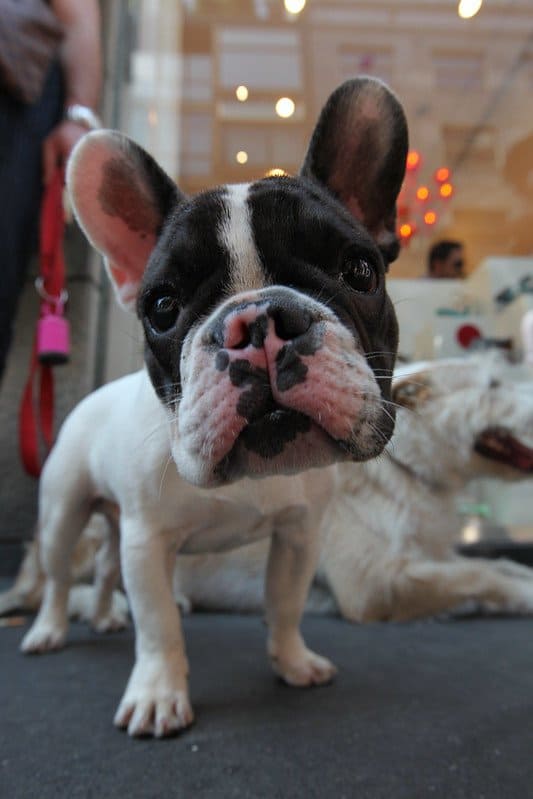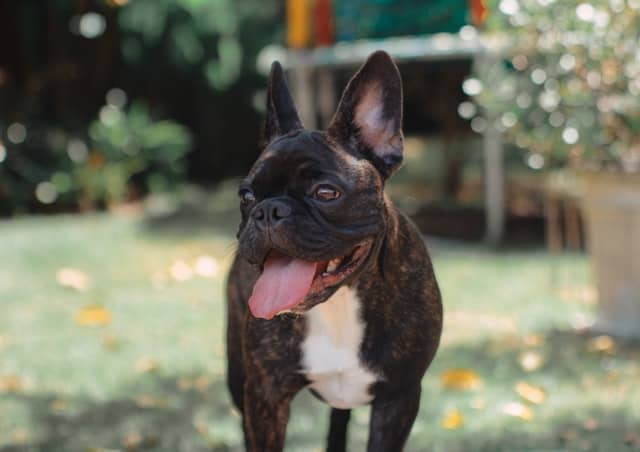
It might be a little confusing to notice that your French Bulldog has abnormally long legs for their size. As they grew up, you were probably expecting your Frenchie to have the traditional small head and broad chest combined with the short little legs, but instead they ended up with a height closer to their English cousin. So what are the most likely reasons behind your Frenchie’s unusually tall stature?
Why is my French Bulldog so tall?

Although there are a few different kinds of French Bulldogs, they all usually remain rather petite and don’t often grow beyond a certain size. So then how do you explain a Frenchie that is taller than average? It shouldn’t surprise you to know that the most likely scenario is that your long-legged friend is a mixed breed. Your Frenchie may just be a special case of fluke genetic expression, but the chances are that they simply aren’t a purebred.
There have been others who have wondered the same things about their lanky Bullie. However, all the statistics on French Bulldogs suggest that if your dog’s size exceeds certain measurements then it’s doubtful they are a pure-blooded Frenchie. This might be troubling to discover seeing as you were probably reassured of their purebred status when you bought your pup.
- Have you got a French Bulldog with a long tail?
How tall do French Bulldogs get?
A standard French Bulldog should reach a height of around 12″ by the time that they are a year old. They will not grow any taller after this.
And here’s the interesting thing- there is not much difference in the height of a male or female French Bulldog!
How big do French Bulldogs get?
When we talk about how big do French Bulldogs get, it is important to realise that there are two different types of French Bulldogs.
A standard French Bulldog and a teacup, micro or mini French Bulldog.
Standard French Bulldogs, as already stated, will generally grow to be around 12 inches or 30 centimetres high.
But a mini French Bulldog might be anywhere between 8 inches to 12 inches tall, depending on how they are bred.
You see, standard Frenchie’s are AKC (American Kennel Club) registered which gives the breed a degree of “protection” because of the breed standard– which is a list of qualities that a French Bulldog should have.
Micro or mini French Bulldogs are not AKC registered, which gives the breed far less protection and unscrupulous breeders too much flexibility.
To help make it easier for you, I have created a growth chart tracking a standard French Bulldog’s height and weight in their first year.
| Age | Height | Weight |
| 3 months | around 5 inches | around 8 pounds |
| 6 months | around 8 inches | around 16 pounds |
| 9 months | around 10 inches | approx. 21 pounds |
| 1 year | approx. 12 inches | around 26 pounds |
It is important to realise that these markers or milestones are only approximates.
Every dog will grow at a different rate.
Just because your Frenchie isn’t exactly five inches at the age of three months (or 10 inches when they are nine months old) isn’t something to worry about too much.
A male and female French Bulldog will generally be around the same height.
The key difference is that male French Bulldogs weigh more, they have more muscle and bulk and so they will be a few pounds heavier.
Why is my French Bulldog tall and skinny?
There are a 4 main reasons why your Frenchie could be tall and skinny:
- They are still young
- Food isn’t nutritious enough
- They are a rescue animal
- They have a serious health condition
Your dog might be too skinny because they are still young and have some growing and filling out to do.
As I explain later, French Bulldogs should reach their maximum height by about the age of 12 months but they can take another year to fill out and develop all their muscles.
It could also be that your French Bulldog is too skinny because the food that you are feeding him isn’t nutritious enough.
Buy the most expensive food that you can afford and make sure that it is good quality.
If you rescued your French Bulldog, the chances are that they are too thin and need to put on weight.
A study in 2019 of 900 rescue dogs found 47% of them were underweight.
Feed them well and in a few months they shouldn’t look quite so skinny.
And the final reason that your Frenchie might look too skinny is because they might have a serious underlying health condition.
What different types/sizes of French Bulldogs are there?

As demand for pocket-sized pups has grown over the last few years, breeders have found a few different ways to create the kind of miniature dogs that people are looking for. Sometimes it’s as simple as putting together the smallest pups of two different litters in the hopes that their dinky genes will carry forward in their offspring.
Crossbreeding Frenchies with other smaller breeds is another common practice, which can explain why people sometimes end up with a French Bulldog that is unusually tall or that has extra-long legs.
As well as having different sizes from the Mini Frenchie down to the Teacup Frenchie, they also have a variety of patterns and styles that distinguish them from one another. The Fawn French Bulldogs usually have an unbroken pattern, meaning that their typically cream-coloured coat is solid across their head and body.
The Pied French Bulldog has one whole colour (normally white) throughout as well, although with a few small sections of a darker colour here and there. Sometimes they’ll have one area in particular that stands out, earning them a cliché name like “Spot”. Such patches are typically found by one of their eyes.
The Brindle French Bulldogs mostly have dark base colours with brighter patches scattered about. They have a number of different styles, such as the Seal Brindle Frenchie who often has fine white fur that is difficult to see, which could lead you to think they are just plain black. The Black Brindle Frenchie is among the most frequently found in this breed. Their pure black colour is particularly common. The Tiger Brindle Frenchie has a colourful mix of lighter patches of fur in a pattern similar to that of a tiger. Then there’s the Brindle Pied Frenchie which is typically white with numerous darker segments all over. Sometimes the dark shading only shows up on a single foot or around one eye, but it’s also sometimes present on the face or back and can even show up in a pattern not unlike what you’d see on a cow.
The rarest of the bunch is the Blue/Grey Frenchie. The change in their genetics passed down from both the mother and father creates a shift in the regular black colour, making for a more bluish grey appearance.
How long is a French bulldog?
A Frenchie’s length is usually very close to their height. A normal adult French Bulldog will stand at roughly 12 inches (30cm) tall and weigh between 16 to 28 pounds (7.2 to 12.7 kilograms). Males tend to weigh a little more than the females do. Of course there are exceptions to these measurements but it’s uncommon to see a Frenchie exceeding these dimensions unless they are a mixed breed.
Why has my French Bulldog got short legs?
At the other extreme, some owners want to know why their French Bulldogs have short legs. And there are a few reasons for this.
Firstly, it could be because your haven’t got a standard French Bulldog but you have a teacup Frenchie, which is a type of French Bulldog which is bred to be even smaller than the standard breed.
Secondly, it could be that you haven’t got a pure bred French Bulldog but you have a French Bulldog mix. Possible mixes that can quite easily be mistaken are a Frug (a French Bulldog and Pug mix) and a French BoBulldog (a French Bulldog and Boston Terrier mix.)
And thirdly, a more unlikely possibility, is that you have a young standard French Bulldog whose legs have yet to grow fully. However, this is quite unlikely as most puppies, even Frenchies, have a “lanky” phase (around the age of 6 months) when their legs seem too long for the rest of their body.
When do French Bulldogs heads get bigger?

I’m sure at some point you’ve looked at your little pal and wondered whether or not their tiny head is ever going to get any bigger. Well, a Frenchie’s head is said to only grow in the first 12 months of its life. After the first year their head supposedly stops growing, which can sometimes lead to a disproportionate-looking pooch depending on their weight, but it is perfectly normal.
The average size of a French Bulldog’s neck is about 14 inches (35cm) and the circumference of their head can range from 13 to 18.5 inches (33 to 47cm). Since they have such teeny heads, you need to be careful with your Frenchie around the pool as they aren’t the best swimmers. They have enough breathing problems as it is, so keeping their small head above the water might be a challenge that you don’t want to have to face.
At what age is a French Bulldog fully grown?
Overall, the Frenchie reaches the extent of their fundamental growth anywhere from 9 to 12 months old. They should be completely matured by the time they get to the 2 year mark. In their second year, they’ll put on a bunch of much needed weight to fill out their tiny structure. Maintaining a good health in their early years of development is essential for proper growth. You want to make sure they get enough food of the highest quality to adequately fuel their growing body and inquisitive mind. Illness in the beginning few weeks of growth can also affect your pup’s level of development and overall size.
There is a basic method you can use to estimate how much your dog will weigh once they’re fully grown. When they reach 8 weeks old, multiply their weight by 4 and you’ll get a rough idea of what you can expect. Alternatively, if you double what they weigh at 4 months old you’ll get your estimate. For bigger breeds such as Great Danes, you should calculate the estimate at 5 months old instead of 4 months to get a more accurate measurement.
- Learn more about how to introduce your French Bulldog to a cat..
How can I tell if my French Bulldog is a purebred?
Breeders sometimes mix and match different types of dogs to get something more suited to what is popular or profitable, often at the cost of the doggy’s health. Common mixes for Frenchies include Pugs, Pitbulls, Boston Terriers, Chihuahuas, Beagles, Poodles, and Australian Shepherds. When buying from private breeders there is a bit of a risk that you might not get exactly what they’re advertising. When buying from a pet shop, you would expect to get what you pay for but this isn’t always the case either. You’ll almost always pay a lot more for a purebred pooch than you would for a mixed breed or a “pavement special”, so you’d be wise to make sure that your dog is legitimately what they’re supposed to be.
If your dog truly is a purebred then you’ll have a better understanding of what you’ll be dealing with when they reach their fullest size and weight. It will also be easier to anticipate their personality traits and which diseases and conditions you should look out for. If your dog is a purebred, it means that his or her parents are both the same breed and the grandparents are also the same breed too. But how do you know for sure if they have an untainted lineage? Of course you can look at other dogs which are supposedly purebred and check to see how similar they are, but this is not a very professional approach as there is a lot of room for error.
If the dog really is purebred, they should come with pedigree documents detailing the ancestral line of the dog over the last 5 generations. This is a more trustworthy way to go about verifying your purebred’s authenticity, but breeders can sometimes lie and create false documents. Your best bet is to do a DNA test. This might sound expensive but it has become much easier to do this these days and it’s the only way to be certain that your dog really does descend from a pure bloodline.
Closing Thoughts
If it turns out that your Frenchie is actually a Frenchton (French Bulldog crossed with a Boston Terrier) or a Froodle (Frenchie crossed with a Poodle), it’s not the end of the world. Your half-blooded or even multi-blooded Frenchie will give you just as much love and companionship as a purebred.
Typically, mixed breeds actually suffer less from the ailments that a lot of pure breeds tend to battle with. Many people will tell you that mixed breeds often have the most unique and interesting personalities as well. Maybe leave a review of the breeder where you got the dog so that other people can be more aware when buying from them.
There are thousands of French Bulldog owners out there who have dogs which for some reason or another, just don’t look right. These include Frenchies with long noses.
Photo credits
¹ Photo by Jay Wennington on Unsplash
² Photo by Artur Malinowski
³ Photo by Josh Henderson
⁴ Photo by Bruno Cordioli





